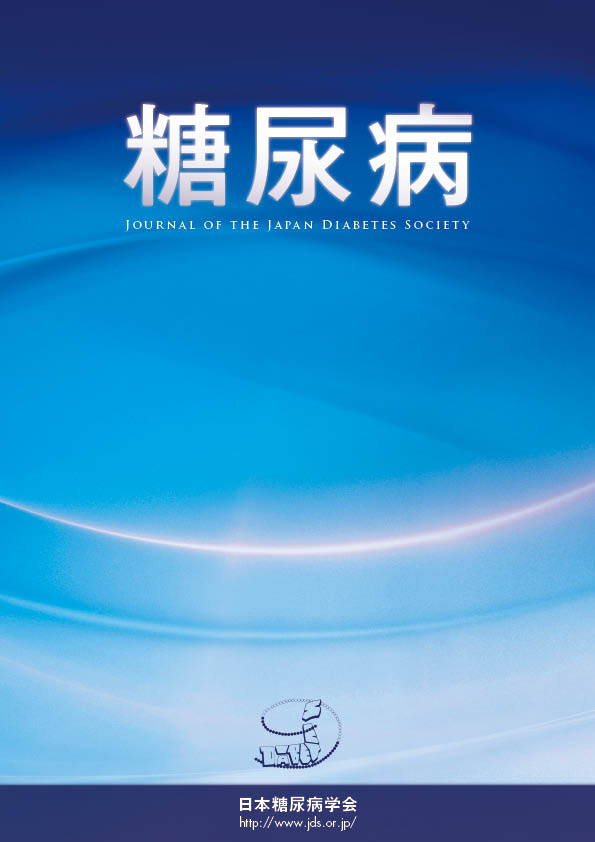
- |<
- <
- 1
- >
- >|
-
Ryotaro Bouchi, Tatsuya Kondo, Yasuharu Ohta, Atsushi Goto, Daisuke Ta ...2022Volume 65Issue 8 Pages 419-434
Published: August 30, 2022
Released on J-STAGE: August 29, 2022
JOURNAL FREE ACCESSDownload PDF (3598K)
-
Mari Tanaka, Hiroyuki Ito, Sachiko Kawakubo, Eiji Kusano, Jiro Kondo, ...2022Volume 65Issue 8 Pages 435-443
Published: August 30, 2022
Released on J-STAGE: August 29, 2022
JOURNAL FREE ACCESSPatients with type 2 diabetes (history of treatment discontinuation, n=78; no history of treatment discontinuation, n=516) were prospectively observed for 5 years, and the incidence of treatment discontinuation was investigated. Age and a history of treatment discontinuation were associated with treatment discontinuation in the overall population (hazard ratio: 2.17). HbA1c (hazard ratio: 2.12) was significantly associated with treatment discontinuation in patients with a history of discontinuation, while age and BMI were significantly associated with treatment discontinuation in patients without a history of treatment discontinuation. The treatment discontinuation rate after 5 years was 23 % in patients with a history of treatment discontinuation, which was significantly higher in comparison to that in patients without a history of treatment discontinuation (11 %). At the start of the observation period, the HbA1c value was higher in patients with a history of treatment discontinuation; however, after the first year it remained similar to that in the group without a history of treatment discontinuation. The prevalence of retinopathy and nephropathy remained higher in the group with a history of treatment discontinuation. A history of treatment discontinuation is a risk factor for re-discontinuation, and even if treatment is continued, vascular complications cannot be sufficiently reduced. Therefore, it is important to prevent discontinuation from the start of treatment.
View full abstractDownload PDF (597K)
-
Yoshiaki Okubo, Masaki Shimamoto, Kaneyuki Watanabe, Yosuke Oshima2022Volume 65Issue 8 Pages 444-450
Published: August 30, 2022
Released on J-STAGE: August 29, 2022
JOURNAL FREE ACCESSA 45-year-old woman was referred to our hospital because of diabetic ketoacidosis. Six days before the referral, she visited a nearby clinic because of abdominal distension and appetite loss. Tablets for gastritis were prescribed, but her symptoms did not resolve. One day before her referral, she began to feel dizzy and thirsty, and visited her local doctor again. Blood and urine tests were performed. Since the results showed high blood glucose (578 mg/dL) and ketonuria, she was transferred to our hospital. The exhaustion of intrinsic insulin secretion, slight elevation of HbA1c (6.5 %) despite high blood glucose, and the abrupt onset of diabetic ketoacidosis led to the diagnosis of fulminant type 1 diabetes mellitus (FT1D). On presentation, her BMI was >40, which is rare for FT1D. She was found to be positive for GAD antibodies, which is also unusual for FT1D. This is the first reported case of GAD antibody-positive FT1D in an individual with class 3 obesity.
View full abstractDownload PDF (523K) -
Yuko Tamaki, Yasuhiro Niida, Miyuki Koizumi, Hiroki Nakajima, Fumika K ...2022Volume 65Issue 8 Pages 451-457
Published: August 30, 2022
Released on J-STAGE: August 29, 2022
JOURNAL FREE ACCESSA 65-year-old woman presented with poorly controlled type 2 diabetes mellitus and inappropriate secretion of TSH. Pituitary MRI showed a microadenoma; thus, TSH-producing pituitary adenoma was suspected. After admission, she was treated with metformin, an SGLT2 inhibitor, and insulin. A T3 suppression test was performed for the differential diagnosis of SITSH. Just after the T3 suppression test, the patient showed sudden and severe vomiting, fever, tachycardia, hyperglycemia, hyperketonemia, hyperlactacidemia, and metabolic acidosis. She was diagnosed with thyroid storm and diabetic ketoacidosis, and was treated with infusion and insulin. Thereafter, she rapidly recovered. In this case, it was considered that the T3 suppression test under metformin and/or SGLT2 inhibitor treatment caused the thyroid storm and diabetic ketoacidosis. The adjustment of antidiabetic drugs and appropriate use of insulin during sickness (including thyrotoxicosis) are important for the prevention of thyroid storm and diabetic ketoacidosis.
View full abstractDownload PDF (1005K) -
Tomofumi Yamazaki, Yoshio Nagai, Kyohei Horiguchi, Naoyasu Kashima, Ko ...2022Volume 65Issue 8 Pages 458-463
Published: August 30, 2022
Released on J-STAGE: August 29, 2022
JOURNAL FREE ACCESSGlutamic acid decarboxylase (GAD) antibody, an islet-related autoantibody, is frequently found in the early stage of type 1 diabetes. Although the antibody titer decreases over time, it is uncommon for the antibody to disappear within months. We experienced the case of a patient with diabetes in which a GAD antibody test was positive during treatment for COVID-19 and negative thereafter. A 43-year-old man with type 2 diabetes was admitted to our hospital with COVID-19 pneumonia. He had an eight-year history of impaired glucose tolerance and had been treated only with diet and exercise therapy. On admission, a GAD antibody test was positive, but a second test seven months later was negative. The human leukocyte antigen (HLA) genotype was DRB1*09:01-DQB1*03:03, which is reported to be a disease-sensitive haplotype for type 1 diabetes in Japanese people. This case indicates that a GAD antibody test may be positive in patients with diabetes and COVID-19 and may become negative after recovery from COVID-19. In similar cases, physicians should be cautious when diagnosing the type of diabetes and should monitor the GAD antibody titer and insulin secretory capacity and ideally examine the HLA haplotype.
View full abstractDownload PDF (360K)
-
2022Volume 65Issue 8 Pages 464-474
Published: August 30, 2022
Released on J-STAGE: August 29, 2022
JOURNAL FREE ACCESSDownload PDF (636K)
- |<
- <
- 1
- >
- >|